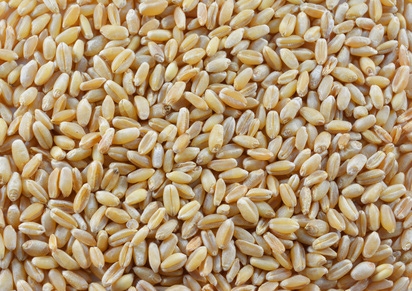What the Heck is Kamut?
Broaden your horizons with this ancient, flavorful, and nutritious grain!

With the growing awareness of the health benefits of whole grains and the health risks associated with gluten, various so-called ancient grains have become part of the healthy eating trend. Whole grains have been part of our diets for millennia, thus the label “ancient.” For the most part, the terms whole grains and ancient grains are used interchangeably to reference barley, corn, oats, rye, and whole wheat. However, there are some pseudo-grains, including amaranth, buckwheat, and quinoa, routinely included in discussions of ancient grains because they are compositionally akin and used in similar ways.
Grains are members of the grass family (Poaceae). They produce a dry, edible seed-like fruit, most commonly called a berry, kernel, or grain. The pseudo-grains amaranth, buckwheat, and quinoa are not members of the grass family. Other ancient grains and pseudo-grains that have come to the fore as a result of the healthy eating trend are einkorn, faro, Kamut (pronounced “ka-moot”), millet, sorghum, and spelt.
Kamut is possibly the most intriguing and mysterious of the ancient grains. This is first and foremost because of its history. Kamut is the brand-name for khorasan, an early, large-grained form of wheat that is a relative of durum. (“Kamut” is an ancient Egyptian word meaning wheat).
While tales of its origins are probably apocryphal, it’s still a lot of fun to consider the possibility that Kamut was rediscovered in the tomb of an Egyptian pharaoh (thus the nickname “King Tut’s Wheat”), or even further back in time aboard Noah’s ark (why it’s referred to as “Prophet’s Wheat”). Regardless of the veracity of these stories, it was definitely originally cultivated in Egypt or Asia Minor. Fast-forward to today in the US, where khorasan wheat has been patented as Kamut by the Quinn family of Montana and is only grown organically.
Its organic-only status undoubtedly makes Kamut appealing to those who are health-conscious and nutritionally aware. But there’s a lot more to it than that. Like many whole grains, Kamut is an amazing fount of antioxidants, fiber, minerals, protein, and vitamins. All of these things work in concert to improve your health when Kamut and other whole grains are added to your diet. Ancient grains can help to reduce the risk of cardiovascular disease and type-two diabetes. They can also improve digestive health because the fiber helps prevent constipation and makes it more difficult for digestive enzymes to break down starches into glucose. There are claims that those who are sensitive to other wheat products do not have as strong a reaction to Kamut, making it supposedly safe for people with wheat allergies or gluten intolerance (celiac disease). However, such reactions vary greatly from individual to individual; it’s best to proceed cautiously if you’re sensitive to wheat. There are other claims that Kamut is a “high energy grain,” because of its higher percentage of lipids, which produce more energy than carbohydrates, making it well-suited for athletes and others looking for quality nutrition for competition and training.
But none of its interesting history or nutritional wealth matters if Kamut doesn’t taste good or isn’t a pleasure to eat. Fortunately, a lot of people think it’s delicious and enjoyable! As Maria Speck, the author of the award-winning Ancient Grains for Modern Meals, refreshingly confesses in the forward of her cookbook:
Almost every conversation about my passion for whole grains evokes this well-meaning remark: “Your diet must be very healthy.” This comment always leaves me speechless, because health is the last thing on my mind when I eat … Whole grains and their tantalizing textures and fantastic flavors made me so curious about food that I started to cook. Soon, I was on the best diet I have ever been on.
In Ancient Grains for Modern Meals, Speck provides recipes for cooking all kinds of things using whole grains, including colorful, tasty, and versatile Kamut. It has a buttery, nutty flavor and, because it is naturally higher in sugar, it has a sweeter taste than traditional wheat. Kamut berries have a chewy, firm texture and a bronze-gold color. They can be used interchangeably with barley, wheat berries, or even corn. Kamut is a slower-cooking grain, and therefore holds its shape well and can be used in soups and stews without getting mushy.
Maria Speck’s blog and her cookbook, as well as the official Kamut website are all impressive sources of Kamut recipes. Why not give cooking with Kamut a try and let us know how the kamut it worked for you?
Update: Many thanks to KAMUT Brand khorasan wheat for providing us with some clarifications that we would like to share with you! KAMUT Brand khorasan wheat is a trademarked (not patented) grain. As such, it is a variety of khorasan wheat that is always grown organically, never hybridized or modified, and required to meet certain nutritional and quality standards. Other farmers can and do grow khorasan wheat, they just can’t call it KAMUT Brand khorasan wheat. The word “KAMUT” was derived from hieroglyphics and does not mean wheat, but rather something untranslatable and similar to “soul of the earth.”

Jean Grigsby
Jean Grigsby is a writer, who lives on the banks of the Kennebec River in Chelsea, Maine. She enjoys working out, reading, and running her marketing and public relations business, The Write Approach. Her article, Where Are All The Birds? appears in the 2021 Farmers' Almanac.






As a gluten gut intolerant person, I would Never switch to using Kamut, einkorn, faro as these are Still wheat. Even spelt is a risky grain. It’s the molecular structure of grain, the protein part especially, that is the problem causer…. Not the age type of grain. Don’t eat soy either because the molecular structure is too similar to the molecular structure of wheat grains, the body system often is confused by it and causes the same gut wrenching reactions that wheats produce. However it’s good to have the article explain what these ancient wheats are called and their physical make up.
If it’s like the rest of the items that might help my husband with his kidney failure it will be expensive.
Where is it grown? What’s the market for it if any? How does it yield? Do you combine it like small grain?
Very informative. I am going to look into this.